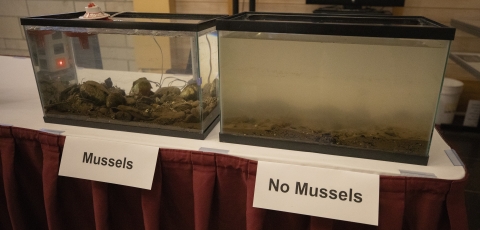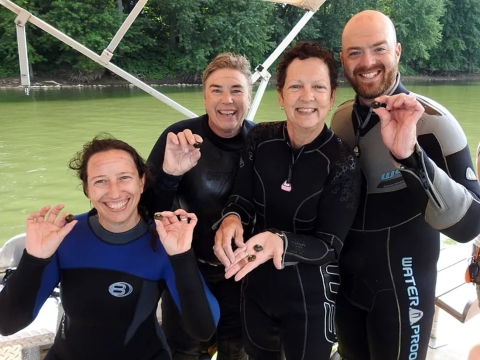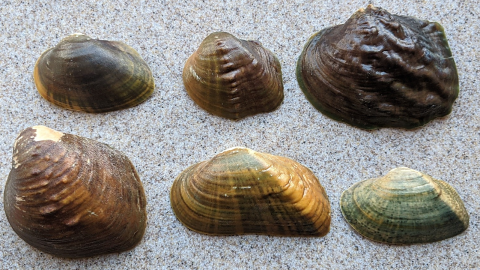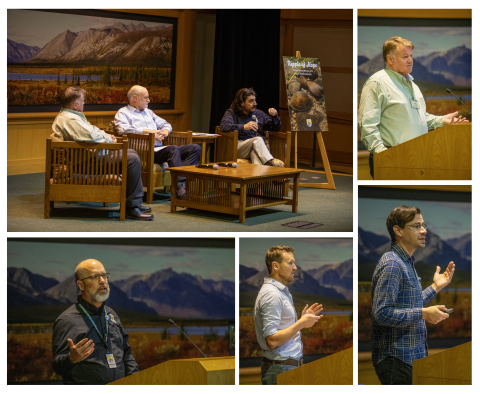On December 7, 2023, U.S. Fish and Wildlife Service experts and partners convened at the National Conservation Training Center in Shepherdstown, West Virginia, for the Ripple of Hope event. This celebration marked the 50th anniversary of the Endangered Species Act and showcased innovations in freshwater mussel conservation.
"Freshwater mussels are essential to the health of rivers and streams. This is essential not just to the fish, mammals, and birds that depend on them, but to all of us as humans who rely on clean, plentiful water." said U.S. Fish and Wildlife Service Acting Deputy Director Amy Lueders. In fact, a single freshwater mussel can filter 5-10 gallons of water every day! Despite their importance, freshwater mussels are some of the most endangered animals. There are nearly 100 protected species under the ESA in the United States, and many are at risk of extinction. Years of widespread pollution, overharvesting, and dam construction have imperiled their populations.
The ESA provides the protection of ecosystems, conservation of endangered and threatened species, and enforcement of all treaties related to wildlife preservation. Working with state and conservation partners, the Service has placed a strong emphasis on evaluating mussel populations and establishing regulations to safeguard these species. Freshwater mussel conservation efforts have expanded exponentially, which led the National Conservation Training Center to "shine a spotlight on the amazing conservation milestones related to freshwater mussel conservation," said NCTC Director Steve Chase. The Ripple of Hope event was offered as part of the Conservation Lecture series at NCTC.
The ESA is one of the world’s most effective wildlife conservation laws, and the Service has been celebrating its 50th anniversary throughout 2023. Thanks to the ESA, the Service and its partners have come together on many collaborative conservation efforts to work toward the recovery of ESA-listed species as well as many other imperiled species. It’s up to all of us to continue the success of the ESA and ensure future generations can experience the wonders of the natural world we all cherish.
There are many stories about the ESA unfolding, and the work around freshwater mussel conservation continues. Read on for more information about how freshwater mussel conservation efforts and partnerships are creating ripples of hope in conservation, science, technology, and communications!
A Story of Contrast, Ripples of Hope in Conservation
For nearly 40 years, Service Supervisory Biologist Bob Anderson has worked on the conservation of freshwater mussels. Early on in his career, Bob collaborated with landowners and partners with assistance under the ESA to protect water quality in Fish Creek, a small stream in northern Indiana and Ohio. Fish Creek was the last known location of the federally endangered white cat's paw mussel. In 1993, a diesel fuel spill impacted the lower part of Fish Creek and the white cat’s paw has not been seen since 1999.
Bob, in turn, shared a hopeful story about the purple cat’s paw, a mussel species once presumed extinct and a close relative of the white cat’s paw mussel. On the other side of Ohio, a graduate student discovered a small purple mussel shell in 1994. The purple cat’s paw was far from its expected habitat.
Since that time, successful captive propagation efforts have led to hundreds of purple cat’s paws being released and reintroduced into historic habitats, under section 10j of the ESA, in the Ohio River and on the Ohio River Islands National Wildlife Refuge. The purple cat’s paw remains listed as federally endangered under the ESA, but these reintroductions are critical recovery actions that the Service, federal and state agencies, and other partners can conduct utilizing the tools of the ESA.
While freshwater mussels still face many challenges, ongoing efforts to restore habitats and improve propagation offer hope for the recovery of other endangered species across the United States.
Ripples of Hope in Science
The Endangered Species Act creates ripples of hope in science by facilitating and advancing discoveries. One hopeful discovery involves understanding how freshwater mussels complete their life cycle. "What a moment in time for conservation to discover how these mussels complete their lifecycle and need host fish species. In some cases, endangered fish are the only fish host species for some freshwater mussels," said David Miko, the Service’s Fish and Aquatic Conservation Program Assistant Director.
"Understanding freshwater mussels' complex life cycle has really pushed us forward in terms of propagation," said NCTC Fish and Wildlife Biologist and Course Leader Matthew Patterson. "The methods, techniques, and adaptations that have developed in freshwater mussels and allowed them to attach their larvae to the fish to complete metamorphosis are fascinating.” For example, the pocketbook freshwater mussel has adapted its mantle lure to look like a fish, complete with fins, eye spots, and even a lateral line, resembling a minnow fish. The bass serves as the host fish for the mussel’s larvae.
A challenge in freshwater mussel conservation is finding and identifying physical specimens. If found, the same species can be difficult to identify because of variable appearances, dependent on the life cycle stage or where they are found in the river. Finding and identifying freshwater mussels is essential to measure how well a species is doing in terms of survival and propagation.
The Smithsonian National Museum of Natural History has the largest biodiversity collection in the United States. "Our collections are rich in both historic and current content, having been accumulated over the last 150 or more years. In the past, it was hard to access that information because you'd have to be in the building using the collection or using one of the world's major libraries", said Dr. Scott Miller, senior biodiversity advisor and senior research entomologist of the Smithsonian National Museum of Natural History. Also, with the museum, according to Research Zoologist and Curator of Bivalvia Dr. John Pfeiffer, "these specimens are incredibly important to understanding freshwater mussel biodiversity, and [for that reason] natural history collections are dedicated to increasing the accessibility of the specimens through digitization."
Ripples of Hope in Technology and Communications
Thanks to ripples of hope in communications and technology, you don’t have to go to a museum or search rivers and streams to find freshwater mussels. You can now compare multiple specimens of the same or different species online and even print them out in 3D! With funding provided by NCTC and the Chesapeake Bay Foundation, imaging experts created 3D shell models based on specimens from the Florida Museum of Natural History and the Smithsonian National Museum of Natural History. The 3D models are being used to educate the public and train conservation biologists to identify freshwater mussel species in the United States.
Through this incredible partnership, a 3D library of almost all freshwater mussel species in the United States, is a reality. It is taxonomically comprehensive, digitally accessible to all, interactive, and 3D printable. The hyper-realistic freshwater mussel replicas are created using CT scanning, photogrammetry, and 3D printing. Zack Randall, manager of the digital imaging division with the Florida Museum of Natural History, explained how these images were created by "approximating a three-dimensional structure structure
Something temporarily or permanently constructed, built, or placed; and constructed of natural or manufactured parts including, but not limited to, a building, shed, cabin, porch, bridge, walkway, stair steps, sign, landing, platform, dock, rack, fence, telecommunication device, antennae, fish cleaning table, satellite dish/mount, or well head.
Learn more about structure using common feature points in multiple images." Zack described how CT scans capture internal detail without harm, while photogrammetry uses numerous photos to build stunning 3D models with vibrant color and texture. This combo delivers scientific accuracy and museum-quality beauty.
Despite these technological advancements, there is still much work to be done. Dr. Joseph Wood, Virginia senior scientist for the Chesapeake Bay Foundation said, "One of the most tragic aspects of the decimation of freshwater mussels is that very few people are even aware of the losses that have occurred." As a conservation community, we must recognize that few people are aware of the freshwater mussels' existence, struggles, and value. Training, education, and public outreach are critical to encouraging different perspectives, ideas, and contributions to bigger-picture conservation efforts.
Let's continue creating substantial ripples of hope in conservation, science, technology, and communication!
Note:There are many who contributed to this article and the Ripple of Hope event, including: Zachary Randall, Florida Museum of Natural History; Scott Miller and John Pfeiffer, Smithsonian National Museum of Natural History; Joseph Wood, Chesapeake Bay Foundation; and Amy Lueders, Steve Chase, David Miko, Robert Anderson, Matthew Patterson, Vanessa Kauffman, Gabriela Kallgren, and Melissa Fisher, U.S. Fish and Wildlife Service.







